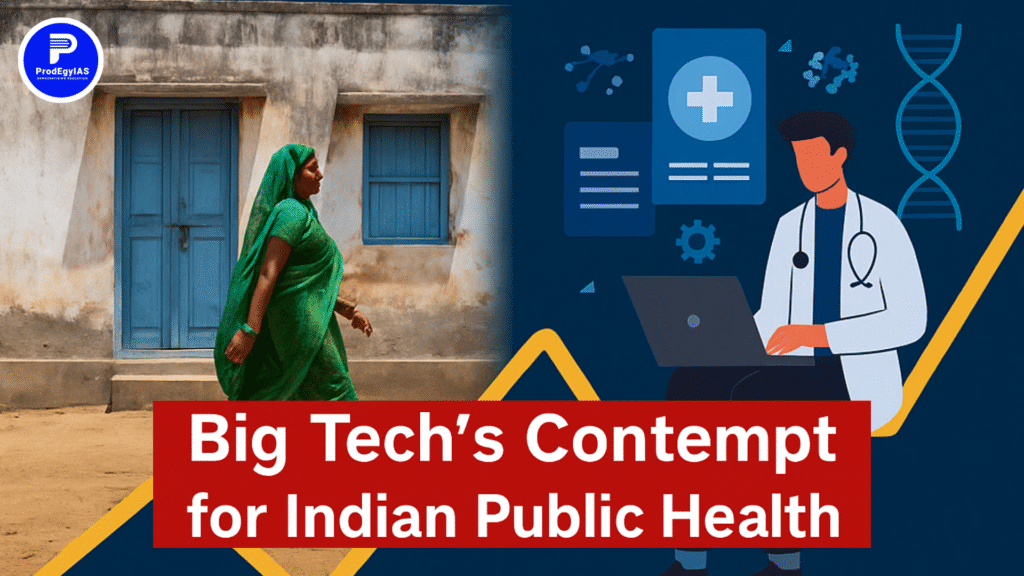
An age of digital empowerment, more accessibility, and reasonably priced treatment was promised by the swift entry of international big-tech businesses and health-tech platforms into India’s healthcare system. Beneath these promises, however, is a disturbing reality: many of these entities disregard the actual needs of India’s disadvantaged communities in favor of profit, data extraction, and market domination above public health equality.
The Promise vs The Reality
The focus of big-tech healthcare newcomers was on app-driven health delivery, AI-based diagnostics, and teleconsultations. These developments seemed revolutionary on paper. Digital tools, however, cannot take the place of India’s primary care systems, skilled healthcare professionals, and lacking infrastructure.
Instead of focusing on quantifiable health outcomes, many health-tech models aim on growth and valuation. Healthcare has changed from being a public service to a business endeavor due to private investments, which have commodified care and produced exclusive models that cater exclusively to urban elites with digital connections.
How Contempt Manifests
1. Ignoring those on the margins
Most platforms target affluent, urban audiences rather than low-income and rural communities. The “digital gap” prevents millions of individuals from participating in the “digital health revolution.”
2. Data Misuse & Algorithmic Bias
Automated diagnosis and AI-based decision systems sometimes ignore contextual, linguistic, and cultural variation. The commercial exploitation of patient data without necessary consent is made possible by inadequate regulation.
3. Insufficient Accountability
Corporate health-tech projects often operate in murky waters, with minimal oversight and not subject to traditional medical ethics. Privacy, safety, and quality standards are weakened as a result.
Implications for India’s Public Health Agenda
If digital health is just motivated by market logic, India’s public health priorities — universal access, equity, and affordability — run the risk of being neglected. Public accountability cannot be replaced by technology.
The confluence of profit-driven internet companies and government-led programs like Ayushman Bharat runs the risk of creating a two-tiered healthcare system: one that is dysfunctional for the poor and digital for the rich. In order to ensure that technology is in line with national health goals rather than shareholder interests, public institutions need to take back the lead.
What Needs to Be Done
- Strengthen regulation: Implement stringent guidelines on data protection, privacy, and consent for digital health platforms.
- Encourage big-tech companies to participate in public health initiatives and underprivileged areas as a means of fostering inclusive innovation.
- Hybrid infrastructure: Combine digital resources with real-world facilities, front-line staff, and networks of referrals.
- Ethical supervision: Establish impartial ethical and audit committees for AI-powered medical devices.
- Raising public awareness: Encourage citizens to demand accountability and transparency by fostering digital health literacy.
Although the introduction of big-tech into India’s healthcare system has great promise, it runs the risk of exacerbating inequality if ethical standards are not met. Algorithms and investors alone cannot handle public health. Real reform necessitates that digital healthcare be driven by empathy, inclusivity, and constitutional duty and that technology serve people rather than profits.
India’s digital health revolution will only make real progress toward promoting fair and compassionate public health when ethics, technology, and government work together.
UPSC General Studies Paper Preparation
| Topic | |
| UPSC Syllabus | UPSC Free Notes |
| UPSC Optional Subjects | Khushhali Solanki (AIR 61, UPSC CSE 2023) |
Public Administration Optional Exam Preparation
Topic | |
About the Author: Jyoti Verma



